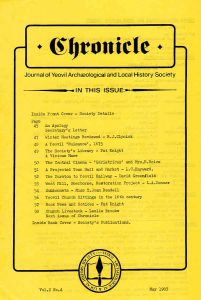1983-May-pg51_A Projected Town Hall and Market
This article came from the Chronicle published May 1983. Page 51
A PROJECTED TOWN HALL AND MARKET
Author: L.C.Hayward
Preserved in the offices of Batten & Co., Church Street, is a plan for a new Town Hall and Market, drawn by Richard Carver, a Taunton surveyor, and dated 18 July 1836. An accompanying schedule of income from the market suggests that the plan was made for the Phelips family as lords of the borough and owners of the market. It provided for a Corn Exchange with an Assembly Hall above it, and in the rear a market for provisions and other goods.
The site in High Street extended to South Street, actually used in 1845 for the Town Hall. The 1836 building would have been set back from High Street, behind a screen of columns with a carriage entrance leading up to a portico. A large vestibule gave access to a Corn Exchange 60ft by 40ft, and to a slightly smaller covered market for butter, poultry, eggs, bacon, and cheese. Between this building and South Street was an open market for flax and general goods, surrounded on three sides by a colonnade for butchers’ stalls, with an iron palisade on the street front and access for the public.
Above the Corn Exchange was an Assembly Room with a balcony above the entrance protico for making announcements. Reading, card and ten rooms opened from it, together with a dining room for formal occasions. Though no elevations are shown on the plan, it is clear that it would have been an imposing and commodious Town Hall to replace the dilapidated Court Chamber, Shambles, and Market in the Borough.
The 1830 Town Commissioners could undertake street improvements and wished to remove the Shambles and Market House from the Borough, but they had no powers to provide a new building. This was not done until the ownership of the market passed from the Phelips family to a new body, the Special Commissioners in 1846. They acted promptly, and a new Town Hall and Market was opened in 1849. This was burnt down in 1935 and never replaced. The building projected in 1836 would have been an even more imposing and commodious one; the failure to carry it out may be explained by the fact that William Phelips, the new owner of the Market, was a minor, and no steps were taken to effect a sale until he reached. his majority in 1845.
The writer is indebted to Mr Henry Batten for the opportunity of studying the plan.
